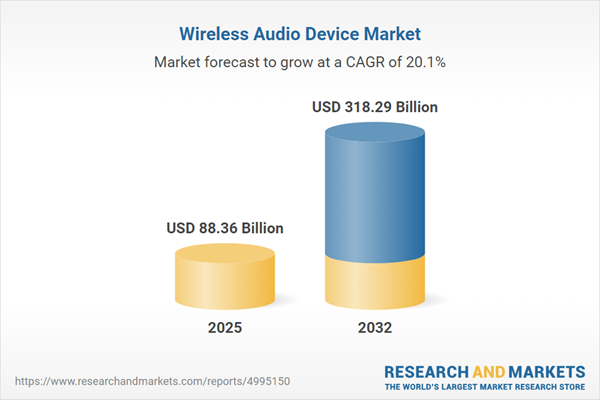Speak directly to the analyst to clarify any post sales queries you may have.
The wireless audio device market is redefining enterprise communications by supporting seamless, mobile, and efficient collaboration across modern organizations. As businesses prioritize flexibility and productivity, integrating wireless audio solutions enables adaptable workflows and continuous innovation.
Market Snapshot: Wireless Audio Device Market Growth Trajectory
The wireless audio device market continues to accelerate, valued at USD 73.55 billion in 2024 and projected to reach USD 88.36 billion by 2025. Anticipated expansion to USD 318.29 billion by 2032 highlights a CAGR of 20.09%.
This growth positions wireless audio solutions as essential enablers of operational efficiency, digital integration, and sustained business connectivity. Widespread adoption in enterprise environments underlines the demand for consolidated communication, agile collaboration, and technology aligned with the needs of global teams. Modern wireless audio technology now underpins robust stakeholder engagement and high-quality connectivity within complex business ecosystems.Scope & Segmentation of the Wireless Audio Device Market
- Product Types: Options include in-ear, neckband, on-ear, and over-ear devices. Enterprises can match device formats to use-cases such as executive conferencing, coworking, hospitality, or employee wellness, with advanced features like active noise cancellation and true wireless designs promoting clarity in all settings.
- Price Range: Choose from entry-level, mid-tier, and premium product lines. This tiered offering ensures businesses can select solutions that match budget parameters while addressing their distinct operational or departmental needs.
- Distribution Channels: Acquisition is flexible, with devices available through consumer electronics retailers, dedicated e-commerce platforms, direct procurement, and specialist vendors. This enables efficient sourcing at both large-scale and specialized levels.
- Connectivity Technologies: Technologies include Bluetooth variants (AAC, aptX, LDAC, SBC), NFC, RF, and Wi-Fi. These solutions enable integration across varied business systems, ensuring compatibility with remote work, collaborative spaces, and meeting environments.
- End Users: Device selection is optimized for senior management, healthcare practitioners, hospitality leaders, and knowledge workers, supporting tailored user experiences and innovation to boost workforce productivity.
- Applications: Wireless audio supports communication, remote and hybrid collaboration, corporate wellness, and multimedia experiences. These applications advance organizational alignment and enhance productivity.
- Regions Covered: The Americas, Europe, Middle East & Africa, and Asia-Pacific. Each region presents unique considerations regarding compliance, regulation, and culture, prompting localized product offerings and tailored go-to-market strategies.
- Featured Companies: Leading suppliers include Apple Inc., Samsung Electronics, Xiaomi Corporation, Huawei Device Co., Sony Corporation, Anker Innovations, Bose Corporation, Harman International Industries, Panasonic Corporation, and Sennheiser electronic GmbH & Co. KG.
Key Takeaways for Senior Decision-Makers
- Wireless audio devices create a unified platform for enterprise communication, driving agile adaptation for distributed, hybrid, or on-site teams across evolving workspaces.
- Advanced noise management and adaptive sound features promote employee focus and resilience in high-demand and variable environments, directly impacting organizational well-being.
- Integration with mobile devices, wearables, and productivity platforms results in a cohesive technology infrastructure, streamlining administrative oversight and enhancing consistency in communication.
- Forming strategic supplier alliances allows organizations to proactively address shifting global and regional market changes, supporting business continuity and responsiveness.
- Modular procurement frameworks and responsible hardware planning reinforce compliance with environmental, social, and governance priorities, strengthening enterprise resilience over time.
- Deploying virtual demonstrations and remote-access sales mechanisms accelerates project onboarding and simplifies adaptation to regional requirements in diverse markets.
Tariff Impact: US Trade Measures Influencing Supply Chain Strategies
US tariffs on semiconductors and micro-speakers have prompted many manufacturers to rethink sourcing strategies, emphasizing nearshoring and stronger regional partnerships. Senior leaders are now focused on cultivating supplier relationships and logistics models that safeguard supply chain stability, ensuring adaptability in response to regulatory shifts.
Methodology & Data Sources
This report leverages primary interviews with enterprise stakeholders, comprehensive industry research, and validation from secondary data sources. Methodological rigor ensures a balanced overview of market dynamics and up-to-date regulatory influences shaping B2B priorities.
Why This Report Matters
- Provides detailed segmentation and analysis of wireless audio technologies, supporting informed executive decisions aligned to business strategy.
- Enables leadership teams to anticipate evolving stakeholder requirements, navigate potential operational risks, and quickly address changes within business and regulatory contexts.
- Supports benchmarking and investment planning to sustain operational agility, preparing organizations for future adaptation as the market landscape evolves.
Conclusion
Wireless audio devices are essential components for driving enterprise modernization. This report offers decision-makers the strategic insights needed for building agile, connected, and high-performing organizations across sectors.
Additional Product Information:
- Purchase of this report includes 1 year online access with quarterly updates.
- This report can be updated on request. Please contact our Customer Experience team using the Ask a Question widget on our website.
Table of Contents
3. Executive Summary
4. Market Overview
7. Cumulative Impact of Artificial Intelligence 2025
Companies Mentioned
The companies profiled in this Wireless Audio Device market report include:- Apple Inc.
- Samsung Electronics Co., Ltd.
- Xiaomi Corporation
- Huawei Device Co., Ltd.
- Sony Corporation
- Anker Innovations Limited
- Bose Corporation
- Harman International Industries, Incorporated
- Panasonic Corporation
- Sennheiser electronic GmbH & Co. KG
Table Information
| Report Attribute | Details |
|---|---|
| No. of Pages | 194 |
| Published | November 2025 |
| Forecast Period | 2025 - 2032 |
| Estimated Market Value ( USD | $ 88.36 Billion |
| Forecasted Market Value ( USD | $ 318.29 Billion |
| Compound Annual Growth Rate | 20.0% |
| Regions Covered | Global |
| No. of Companies Mentioned | 11 |









